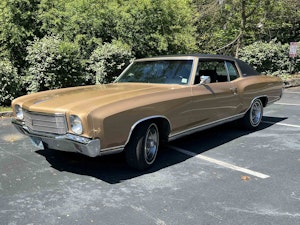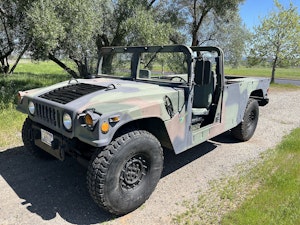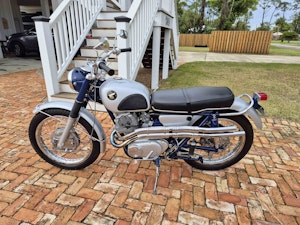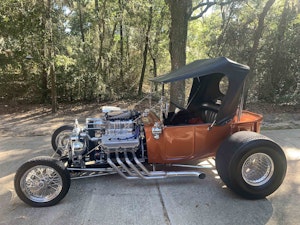Media | Articles
Straightening out your steering is fairly painless, but pack your patience
A few weeks ago, while changing the wheels on one of my BMW 2002tiis, I noticed that there was a loose front wheel bearing that clunked slightly and would not properly adjust. The front wheel bearing was worn and did clunk, but replacing it did not fix the clunking. It turned out that the lion’s share of the noise that I heard in the front end wasn’t from the wheel bearing, but from the steering components. The question was, which ones?
In theory, this isn’t hard to figure out: You have someone rock the steering wheel back and forth while you skooch under the car and lay your hands on each of the steering components. While the exact layout varies car to car, on a 47-year-old recirculating-ball steering system like mine, there’s usually the center track rod, tie rods, steering box, steering arm, idler arm and its bushing, ball joints, and shock tower bushings. On a newer rack-and-pinion setup, there are fewer components, but the tie rods remain. Then you need to isolate the source of the noise. In practice, however, it’s more difficult, because that rocking of the steering wheel doesn’t isolate vertical play in the ball joints or the shock tower bushings. And even with the lateral steering components, it’s often surprisingly difficult to isolate where the play is coming from, or to judge whether a component that has play is actually the source of the clunking you hear.
I had my wife rock the car’s steering wheel while I laid my hands on each of the components and found that the major source of play and clunk was the center track rod (also sometimes called the center drag link) that is moved by the steering box and idler arm and, in turn, moves the tie rods, which turn the wheels. To replace the center track rod, you have to disconnect it from the steering arm, idler arm, and tie rods, which connect both ends of the rod to the steering knuckles at the bottoms of the front struts.
When you need to replace a center track rod and tie rods, the question immediately becomes, how much else to tackle? This can be like exhaust replacement, where the smart move on a car you’re keeping is to go in just once and replace it all. When I encountered this same situation five years ago on my other 1972 2002tii, I used it as the entry point to rebuild the entire front end—struts, ball joints, bushings, lower control arms, everything. It made sense on that car, as there was some amount of play and/or deterioration in those other components.
In contrast, on this car, other than the track rod, things seemed pretty good. On closer examination, however, I noticed that the boots on one of the tie rods had separated, and another tie rod appeared to have a small amount of play. Since the tie rods have to be disconnected to remove the center track rod anyway, replacing them as well seemed smart.
Marketplace
Buy and sell classics with confidence

I did my usual parts sleuthing. I found a New Old Stock (NOS) Febi center track rod on eBay for a good price. Tie rods can be purchased à la carte or as tie-rod assemblies—sets of inner and outer tie rods with the adjusting tube between them. It’s not a big deal to re-use the adjusting tubes; it takes maybe two minutes to swap them over. Still, these days I tend to err on the side of buying things integrated into larger assemblies.
Then there was the question of manufacturer. OEM tie-rod assemblies list at $240 for each side, with discounted prices of about $200. Ouch! The same part from Meyle is about $50. But a few sites offered the same part from Ocap for as little as $34. I weighed the fact that the Ocap tie rods are sold on the sites of many reputable advertisers against the fact that, on some enthusiast forums, Ocap is derisively referred to as “Ocrap.” When I found a vendor that had free shipping, I ordered a pair. Together, all the parts cost me about $125. I felt pretty good.
While waiting for the new parts to arrive, I removed the old components. There’s the old-school way to do this, which is to support the steering knuckle and idler arms with a block of wood and then beat on the top of the shaft with a hammer or insert a wedge-shaped “pickle fork” between the two components and beat on that. But those methods are really frowned upon these days, as they can bend other parts of the front end. You really should use proper tie rod separators and pullers. They’re not terribly expensive. If you don’t want to buy them, you can usually rent them at Autozone or Advance Auto Parts. A search on a good enthusiast forum for your car will usually reveal which ones work on which parts. Some separators are of the straight screw-down type, others are of the lever type. It may take some trial and error to figure out which ones work best on which connections. It’s usually a matter of component size and clearance.
I used my separators to remove the tie rods from the center track rod, and the center track rod from the steering arms. Having the right pullers makes this fairly straightforward, but sometimes it still requires multiple applications of heat and penetrating oil. When the tapered fitting finally lets go, the loud BANG is always surprising.


With everything out, I could directly feel for play in the steering arm, idler arm, and other places. As is the case with most BMW steering boxes, there was some amount of play in the steering arm, but I could adjust the steering box so that when it was on center, it was almost imperceptible. There was just a little play in the idler bushing, but it seemed to only be when the idler arm was pushed vertically, a direction in which it doesn’t move when steered. The ball joints, though original—you can tell because the original ball joints are riveted in—appeared tight, with their boots intact. I checked for vertical play by squeezing them with big slip-joint pliers, and they felt fine.

But when the tie-rod assemblies arrived and I unpacked them, I winced. Rather than the adjusting tubes being black like the originals, they were unpainted silver metal. I looked at product photos on the site from which I’d ordered. This was shown, but the photo was very small. Damn! I disassembled my old ones and tried to use the adjusting tubes and clamps, but for some reason I didn’t like the way they fit. I found a can of flat-black spray paint and painted the tubes and clamps black.


Further, on close examination, the boot on one of the new tie rods was pinched by the spring clamp and didn’t extend all the way down. I carefully pried up the spring clamp, pulled the boot all the way down, and re-installed the clamp, all while grumbling to myself that I should’ve spent the additional money and bought the Meyles.

Everything went back together quickly and easily. In many repairs, assembly goes faster than disassembly, but this is magnified in front-end work, where pullers have to be used to force tapered rods out of holes in which they’ve been sitting for 45 years.


The final step was alignment. In the past, I’ve simply measured the old tie-rod assemblies and adjusted the new ones to be the same length, then driven the car carefully and slowly to an alignment shop. But this time I did something I’ve always wanted to try—aligning the front end using a piece of string. There are several good videos about this on YouTube. Basically, you center the steering wheel, stretch a string from the rear wheel to the front wheel on both sides of the car, and adjust the tie rods so that on each front tire the string is equally far from the fore-and-aft bulges of the sidewall.

For whatever reason, it didn’t work well; when I drove the car, it was still laughably out of alignment. However, through iterative tweaking of the adjusting tubes by a quarter to an eighth of a turn at a time, and then test-driving, I was able to tell when the front wheels changed from toed-out—causing the car to wander—to neutral, to slightly toed-in, to obviously too far toed-in. I backed it off from there and lived with it for a few days, tweaked it a bit more, and finally got it to the point where it didn’t feel out of alignment to me.
So, my arthroscopic surgical strike, just replacing the tie rods and the center track rod, appears to have been successful. Of course, it’s a 47-year-old car, so something else is certain to break or wear out.
***
Rob Siegel has been writing the column The Hack Mechanic™ for BMW CCA Roundel magazine for 30 years. His most recent book, Just Needs a Recharge: The Hack Mechanic™ Guide to Vintage Air Conditioning, is available on Amazon (as are his previous books). You can also order personally inscribed copies here.









